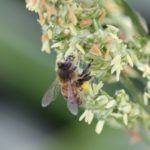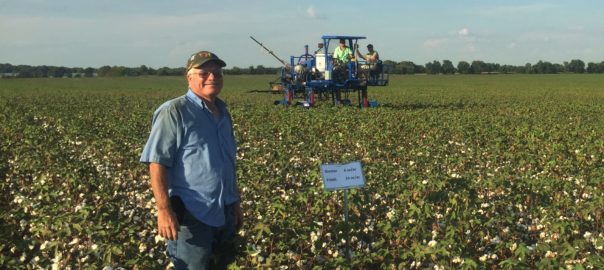As people start considering planting wheat, there are a few things to keep in mind that will save you some unnecessary insect problems. Below are a few bullet points for your consideration. Continue reading
Recent Updates
When harvest equipment breaks, what is the right financial decision?
Producers who have an unplanned need for a harvest machine should evaluate carefully the solutions available to them. Many times, producers will make a quick decision to get harvest back rolling. The decision may be the right one, but sometimes it can have financial consequences.
The most common solutions to getting back into harvest when a combine goes down and can’t be fixed in a timely way are:
- Employ a custom harvester to assist getting the crop out.
- Lease a combine to finish out the harvest.
- Buy a combine for this year and future years.
Let’s look at each one of these possible solutions. Continue reading at Southeast Farm Press.
Mitigating Insect Management Effects on Pollinators (Recorded Presentation)
 The Plant Management Network has released another online presentation in their “Focus on Cotton” series. This new 10 minute video offers suggestions on the steps that growers, pesticide applicators, and beekeepers can take to reduce any negative effects of pesticide applications on honey bees and other pollinators. Link below to watch this presentation narrated by yours truly.
The Plant Management Network has released another online presentation in their “Focus on Cotton” series. This new 10 minute video offers suggestions on the steps that growers, pesticide applicators, and beekeepers can take to reduce any negative effects of pesticide applications on honey bees and other pollinators. Link below to watch this presentation narrated by yours truly.
http://www.plantmanagementnetwork.org/edcenter/seminars/cotton/Pollinators/
Crop Progress – Tennessee and U.S.
ANOTHER GREAT WEEK FOR HARVEST
Continued hot, dry conditions last week were favorable for farmers and kept harvesting at a good pace. The crops that are being harvested show real overall promise for good yields. Soybean harvest is in progress and on track with the 5-year average. Double-cropped soybeans would benefit from rain to help pods fill out and pastures are showing heat stress. Farmers continue to feed hay, which brings with it fear of a shortage this winter. Tobacco cutting is progressing nicely. There were 6.4 days suitable for field work. Continue reading Tennessee NASS report at tn_09_19_16. The U.S. Crop Progress report can be read at cropprog-09-19-2016.

2016 Cotton Defoliation Strip Trial in Lincoln County, TN
A defoliation strip trial was applied in Flintville, TN (Lincoln County) this afternoon (September 16th). A treatment list can be found by clicking here. There are three untreated rows on both sides of the trial. Each treatment is 5 rows wide and signs have been placed in the center of each treatment (row 3).
Tennessee Market Highlights
Corn and cotton were down; soybeans and wheat were mixed for the week. Early this week the USDA released the September WASDE and Crop Production reports (a detailed review of the reports can be found here: http://economics.ag.utk.edu/outlook.html). US corn yield and production were estimated at 174.4 bu/acre (down 0.7 bu/acre) and 15.092 billion bushels, respectively. In Tennessee, corn yields were estimated at 150 bu/acre down 5 bu/acre from last month and 10 bu/acre from 2015. Domestic and foreign corn ending stocks for the 2016/17 marketing year were estimated at 2.384 and 6.256 billion bushels, down 25 and 28 million bushels, respectively. Overall the reports for corn were neutral. Continue reading at Tennessee Market Highlights.
A year for disease – soybean diseases at higher levels
While the earliest planted and maturity soybeans are drying down and being harvested many later planted and maturity soybeans are exhibiting multiple diseases and some pre-mature defoliation may be occurring due to diseases. Continue reading
Comments on Sept. 12, 2016 USDA WASDE Report & Profitability Outlook
This link to UT Monthly Crop Outlook contains a summary of the USDA’s monthly World Agricultural Supply and Demand Estimates (WASDE) report. Domestic balance sheets for corn, soybeans, cotton, and wheat are displayed along with price reaction in futures markets for each commodity on the day of the report release. Additionally, supply and demand estimates for key importing and exporting countries are provided for the current month along with change in estimates from the previous report. The Profitability Outlook section contains estimated returns per acre for each commodity based on 2016 Tennessee state average yield projections and current price offerings (note: cotton prices include a seed and hauling rebate). Variable expenses are based on the University of Tennessee Extension 2016 Row Crop Budgets. Prices are updated monthly; expenses are updated as warranted during the year and may be different than the expenses contained in the 2016 Row Crop Budgets. This section provides an estimation of the current relative profitability amongst major row crops in Tennessee. This month marks a transition to 2017 Profitability Outlook.
The report is prepared monthly by Dr. Aaron Smith and Chuck Danehower.

